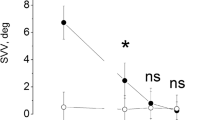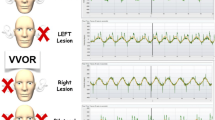Abstract
The characteristics of interaction between two vestibular subsystems (otiliths and semicircular canals) were studied by means of binocular (bilateral) videooculographic recording of eye movements in 43 men aged from 19 to 41 years that had been found healthy upon aviation physical examination. The time course of horizontal vestibular nystagmus was analyzed separately for each eye in subjects who bent forward and straightened up in the sagittal plane while being rotated about the vertical body axis in an electrically driven rotating chair. This combined rotation caused interocular asymmetric nystagmus in 91% of the subjects and convergence rotatory nystagmus in 42% of the subjects. A hypothesis on the mechanism of interocular asymmetric nystagmus caused by the combined rotation and convergence rotatory nystagmus as its special case has been advanced. The hypothesis allows for independent nystagmic mechanisms (subsystems) for the right and left eyes.
Similar content being viewed by others
References
Kislyakov, V.A. and Orlov, I.V., Physiology of Sensory Systems, in Rukovodstvo po fiziologii (Handbook on Physiology), Moscow: Nauka, 1982, part 2, p. 57.
Precht, W., Vestibular Mechanisms, Annu. Rev. Neurosci., 1979, vol. 2, p. 265.
Khilov, K.L., Funktsiya organa ravnovesiya i bolezn’ peredvizheniya (The Function of the Organ of Balance and Motion Sickness), Leningrad: Meditsina, 1969.
Bryanov, I.I., A Method for Studying the Satbility of the Human Vestibualr Analyzer to Cumulated Coriolis Accelerations, Voen. Med. Zh., 1963, no. 11, p. 54.
Kurashvili, A.E. and Babiyak, V.I., Elektronistagmografiya (Electronystagmography), Leningrad: Meditsina, 1970.
Carl, J.R, Practical Anatomy and Physiology of the Ocular Motor System, in Handbook of Balance Function Testing, Jacobson, G.P., Newman, C.W., and Kartush, J.M., Eds., New York: Thomson Delmar Learning, 1997, p. 57.
Raphan, T., Modelling Spatial Orientation of Velocity Storage in Monkey and Man, Equilibrium Res., 1994, vol. 53, no. 1, p. 19.
Greibil, A., Angular Velocities, Angular Accelerations, and Coriolis Accelerations, in Osnovy kosmicheskoi biologii i meditsiny (Principles of Space Biology and Medicine), Moscow: Nauka, 1975, vol. 2, book 1, part 2, p. 265.
Vorob’ev, O.A., The Function of the Vestibular Apparatus as a Gyroscopic System with Double Rotation, Izv. Akad. Nauk SSSR, Ser. Biol., 1984, no. 2, p. 259.
Migliaccio, A.A., Minor, L.B., and Carey, J.P., Vergence-Mediated Modulation of the Human Angular Vestibulo-Ocular Reflex Is Unaffected by Canal Plugging, Exp. Brain Res., 2008, vol. 186, no. 5, p. 581.
Sander, T., Sprenger, A., Neumann, G., et al., Vergence Deficits in Cerebellar Lesions, J. Neurol., 2008, vol. 255, suppl. 2, Abstract O174.
Stolbkov, Yu.K., Interotolithic Symmetry and Asymmetry as Factors of Canal-Otolith Interaction, Fiziol. Zh. SSSR im. I.M. Sechenova, 1990, vol. 76, no. 2, p. 152.
Karmali, F., Ramat, S., and Shelhamer, M., Vertical Skew Due to Changes in Gravitoinertial Force: A Possible Consequence of Otolith Asymmetry, J. Vestib. Res., 2006, vol. 16, no. 3, p. 117.
Maxwell, J.S. and Schor, C.M., Head-Position-Dependent Adaptation of Nonconcomitant Vertical Skew, Vision Res., 1997, vol. 37, no. 4, p. 441.
Baumgarten, R.J. and Thumler, R., A Model for Vestibular Function in Altered Gravitational States, Life Sci. Space Res., 1979, vol. 17, p. 161.
Fernandez, C. and Goldberg, J.M., Physiology of Peripheral Neurons Innervating Otolith Organs of the Squirrel Monkey: I. Response to Static Tilts and to Long-Duration Centrifugal Force, J. Neurophysiol., 1976, vol. 39, no. 5, p. 970.
Markham, C.H. and Diamond, S.G., A Predictive Test for Space Motion Sickness, J. Vestib. Res., 1993, vol. 3, no. 3, p. 289.
Wetzig, J., Reiser, M., Martin, E., et al., Unilateral Centrifugation of the Otoliths as a New Method to Determine Bilateral Asymmetries of the Otolith Apparatus in Man, Acta Astronaut., 1990, vol. 21, nos. 6–7, p. 519.
Gusev, V.N., Kislyakov, V.A., Orlov, I.V., et al., O mekhanizmakh vzaimodeistviya retseptorov vestibulyarnogo apparata (Mechanisms of Interaction of Vestibular Apparatus Receptors), Leningrad: Nauka, 1978.
Shipov, A.A., Kondrachuk, A.V., and Sirenko, S.P., Biomekhanika vestibulyarnogo apparata (The Biomechanics of the Vestibular Apparatus), Moscow, 1997.
Zwergal, A., Brandt, T., and Strup, M., An Ipsilateral Vestibulo-Thalamic Tract in the Medial Lemniscus, J. Neurol., 2008, vol. 255,suppl. 2, Abstract O176.
Tsimmerman, G.S., Ukho i mozg (The Ear and the Brain), Moscow: Meditsina, 1974.
Bock, O., Non-Linear Interaction of the Vestibular and the Eye Tracking System in Man, Exp. Brain Res., 1982, vol. 47, no. 3, p. 461.
Blagoveshchenskaya, N.S., Otonevrologicheskie simptomy i sindromy (Otoneurological Symptoms and Syndroms), Moscow: Meditsina, 1981.
Heide, W., Positional Convergence Nystagmus—A Neurological Disease?, J. Neurol., 2008, vol. 255,suppl. 2, Abstract O178.
Author information
Authors and Affiliations
Additional information
Original Russian Text © O.A. Vorob’ev, S.D. Chistov, T.A. Rybachenko, 2009, published in Fiziologiya Cheloveka, 2009, Vol. 35, No. 5, pp. 54–61.
Rights and permissions
About this article
Cite this article
Vorob’ev, O.A., Chistov, S.D. & Rybachenko, T.A. Convergence rotatory nystagmus under unusual conditions of semicircular canal and otolith stimulation. Hum Physiol 35, 569–575 (2009). https://doi.org/10.1134/S0362119709050089
Received:
Published:
Issue Date:
DOI: https://doi.org/10.1134/S0362119709050089




